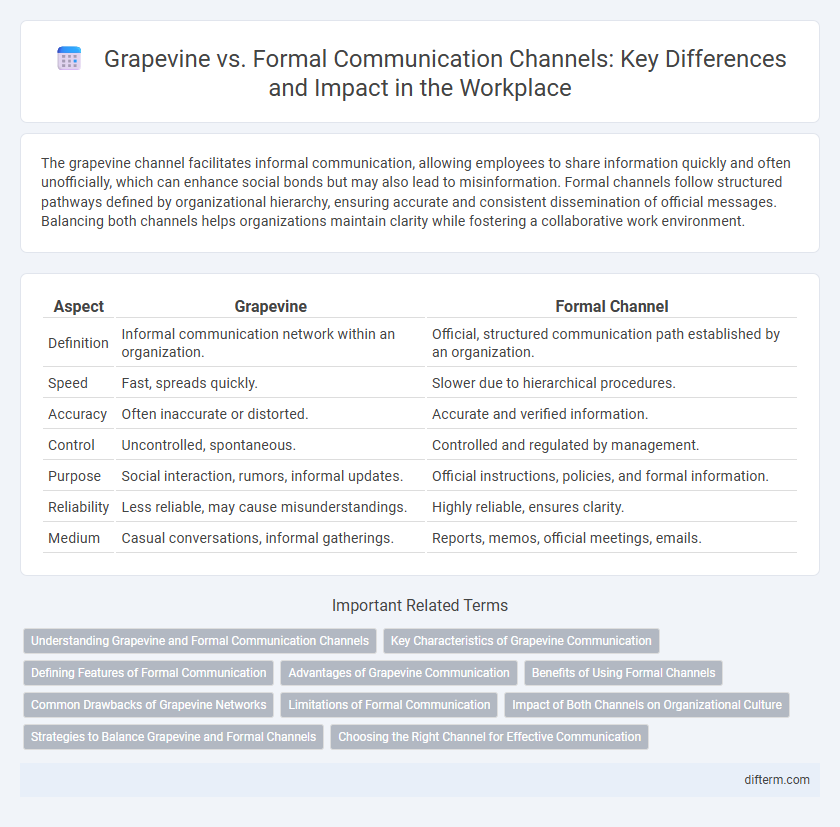The grapevine channel facilitates informal communication, allowing employees to share information quickly and often unofficially, which can enhance social bonds but may also lead to misinformation. Formal channels follow structured pathways defined by organizational hierarchy, ensuring accurate and consistent dissemination of official messages. Balancing both channels helps organizations maintain clarity while fostering a collaborative work environment.
Table of Comparison
| Aspect | Grapevine | Formal Channel |
|---|---|---|
| Definition | Informal communication network within an organization. | Official, structured communication path established by an organization. |
| Speed | Fast, spreads quickly. | Slower due to hierarchical procedures. |
| Accuracy | Often inaccurate or distorted. | Accurate and verified information. |
| Control | Uncontrolled, spontaneous. | Controlled and regulated by management. |
| Purpose | Social interaction, rumors, informal updates. | Official instructions, policies, and formal information. |
| Reliability | Less reliable, may cause misunderstandings. | Highly reliable, ensures clarity. |
| Medium | Casual conversations, informal gatherings. | Reports, memos, official meetings, emails. |
Understanding Grapevine and Formal Communication Channels
Grapevine communication thrives on informal, spontaneous exchanges that often spread faster and reflect employee sentiments more accurately than formal channels. Formal communication channels follow structured pathways defined by organizational hierarchy, ensuring clarity, consistency, and accountability in message delivery. Understanding the differences between these channels helps organizations balance speed and accuracy, fostering effective information flow and employee engagement.
Key Characteristics of Grapevine Communication
Grapevine communication is an informal network characterized by its speed, flexibility, and unofficial nature, allowing information to flow rapidly across different organizational levels. It thrives on personal relationships and social interactions, often spreading rumors and informal news, which can influence workplace morale and decision-making. Unlike formal channels, the grapevine lacks structured oversight, making it less reliable but essential for understanding organizational climate and employee sentiment.
Defining Features of Formal Communication
Formal communication channels are characterized by structured, official pathways established by organizational hierarchy to ensure accurate and consistent information flow. These channels follow predefined rules, often documented in policies, and include official memos, reports, and meetings. The primary features emphasize clarity, accountability, and reliability, minimizing misunderstandings compared to informal grapevine communication.
Advantages of Grapevine Communication
Grapevine communication accelerates information flow by enabling rapid, informal exchanges among employees, enhancing real-time feedback and fostering a sense of community. It often uncovers underlying employee sentiments and informal insights that formal channels might overlook, increasing organizational responsiveness. This communication style can boost morale by promoting social interaction and reducing hierarchical barriers, ultimately supporting a dynamic and adaptive workplace culture.
Benefits of Using Formal Channels
Formal communication channels enhance clarity and accuracy by following structured protocols that reduce misunderstandings. These channels support accountability through documented exchanges, ensuring traceability and responsibility in organizational communication. Relying on formal communication also fosters professionalism and consistency, which strengthens organizational culture and trust.
Common Drawbacks of Grapevine Networks
Grapevine communication often leads to misinformation due to its informal nature and lack of verification, which can compromise organizational accuracy. It tends to spread rumors rapidly, creating confusion and reducing trust among employees. The unpredictability and lack of accountability in grapevine networks make them unreliable compared to formal communication channels.
Limitations of Formal Communication
Formal communication channels often suffer from rigidity, leading to slower information flow and reduced flexibility in adapting messages to specific contexts. The hierarchical structure can cause message distortion as information passes through multiple levels, resulting in delays and inaccuracies. Employees may also feel less engaged or reluctant to share feedback, limiting two-way communication and innovation within the organization.
Impact of Both Channels on Organizational Culture
Grapevine communication shapes organizational culture by fostering informal relationships, enhancing trust, and encouraging open dialogue, which can boost morale and collaboration. Formal channels establish clear communication protocols, reinforce organizational hierarchy, and ensure consistency in message delivery, supporting structured workflows and accountability. The interplay between grapevine and formal channels balances flexibility with order, significantly influencing employee engagement and cultural cohesion.
Strategies to Balance Grapevine and Formal Channels
Balancing grapevine and formal communication channels requires implementing clear policies that validate official messages while acknowledging informal interactions to prevent misinformation. Encouraging transparent dialogue through regular updates and feedback loops enhances trust and aligns organizational objectives with employee sentiment. Training leaders to monitor and guide informal conversations helps integrate grapevine insights into formal strategies, optimizing overall communication effectiveness.
Choosing the Right Channel for Effective Communication
Selecting the appropriate communication channel significantly impacts message clarity and audience engagement. The grapevine facilitates informal, rapid information flow ideal for morale and culture insights, while formal channels ensure accuracy and accountability in official communications. Organizations must assess message sensitivity, urgency, and audience to balance the spontaneous nature of the grapevine with the structured reliability of formal channels.
Grapevine vs Formal channel Infographic

 difterm.com
difterm.com